Bosnia and Herzegovina’s UWCIM team won the BIEA 2019 International STEM Youth Innovation Competition
On the 4th of July, the six-month long BIEA 2019 International STEM Youth Innovation Competition, held at the London Royal Air Force Museum, came to a close. The intense competition included display demonstration, evaluation and flying. The winners of the grand prize and the champion of the 15-17-year age group were the UWCIM team from Bosnia and Herzegovina.
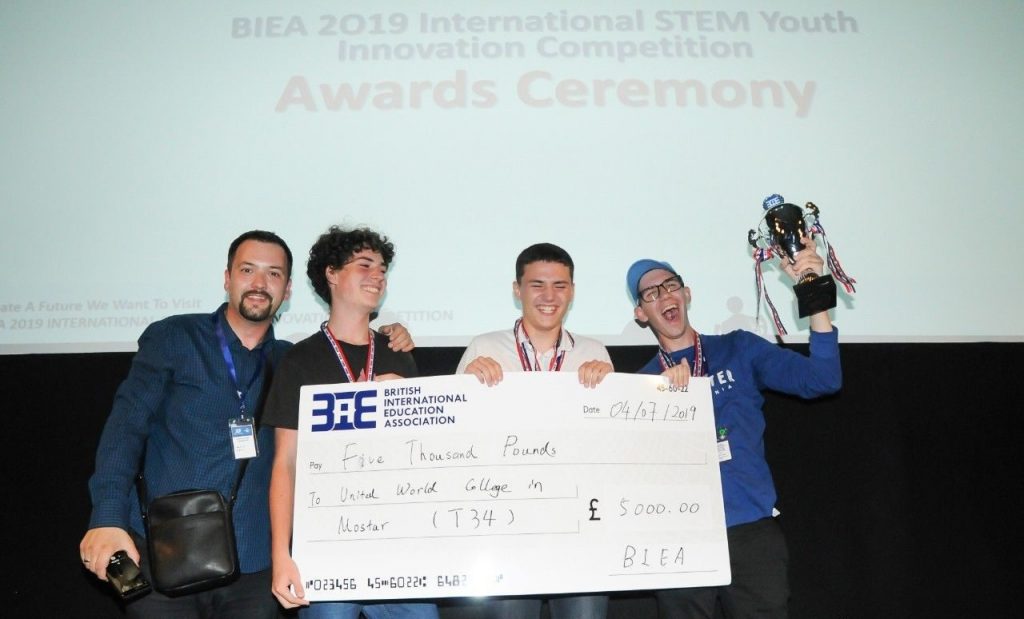
Members of the UWCIM team explained that due to Bosnia and Herzegovina’s previous conflicts, the country is neither developed or rich in educational resources, however, this failed to affect the children’s curiosity and pursuit of knowledge in science and innovation. The UWCIM team comes from the United World College in Mostar, that like other UWC schools around the world, aims to promote world peace and sustainable development by uniting different countries, people and culture through education. The students of the champion team UWCIM are technological innovation enthusiasts, who not only focus of pursuing STEM subjects, but also word hard to find ways to put their creative ideas into practice.
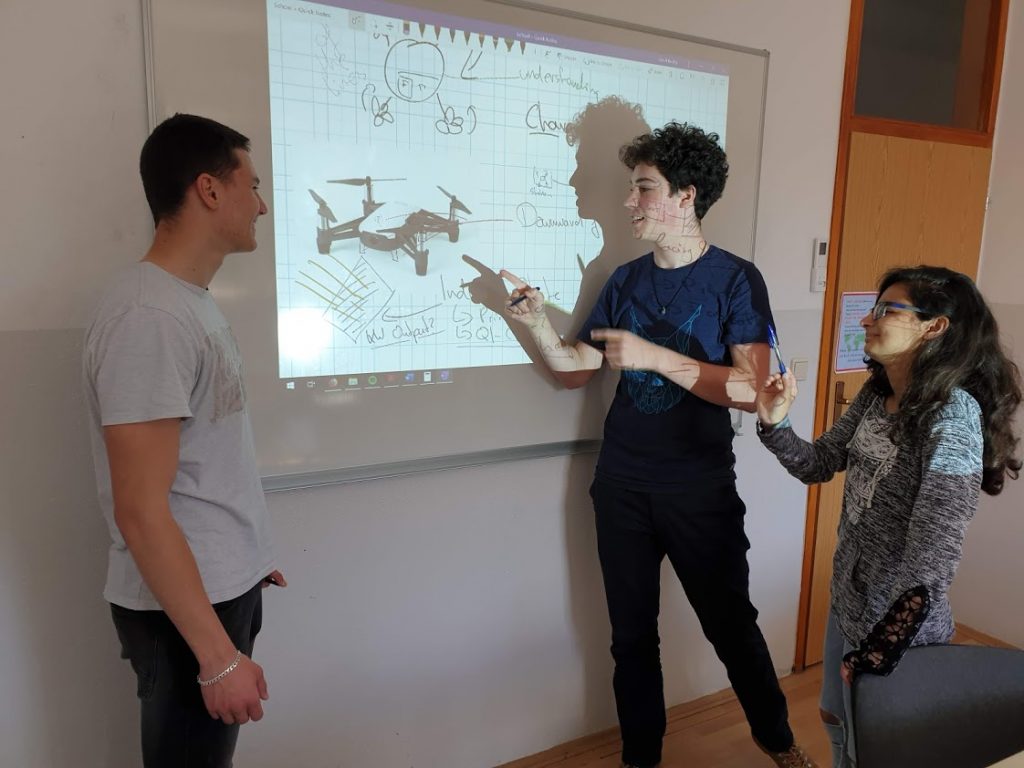
The STEM education in schools’ help develop students’ passion for science and innovation, and the traumatizing history of Bosnia and Herzegovina has further helped develop this devout respect nature and life. While most of the teams focused their “fighting extinction via drone technology” project on counter-hunting, the UWCIM team added a novel focus on how to solve the problem of Egyptian vultures that feed on animal carcasses, as this poses a threat to ecosystems as well as spreading diseases. In the report and video presentations, the team not only showed a solid technical ability, but also outlined how they would use drones to solve this big issue. In particular, the group explained how the war in Bosnia and Herzegonia had left 80,000 bombs in the mountains that in turn threatening the Egyptian vultures home. It poses great challenges to experts and scholars who protect and study them, and it was easy to see that the UWCIM team truly understands the essence of science and innovation as well as the spirit of humanism.
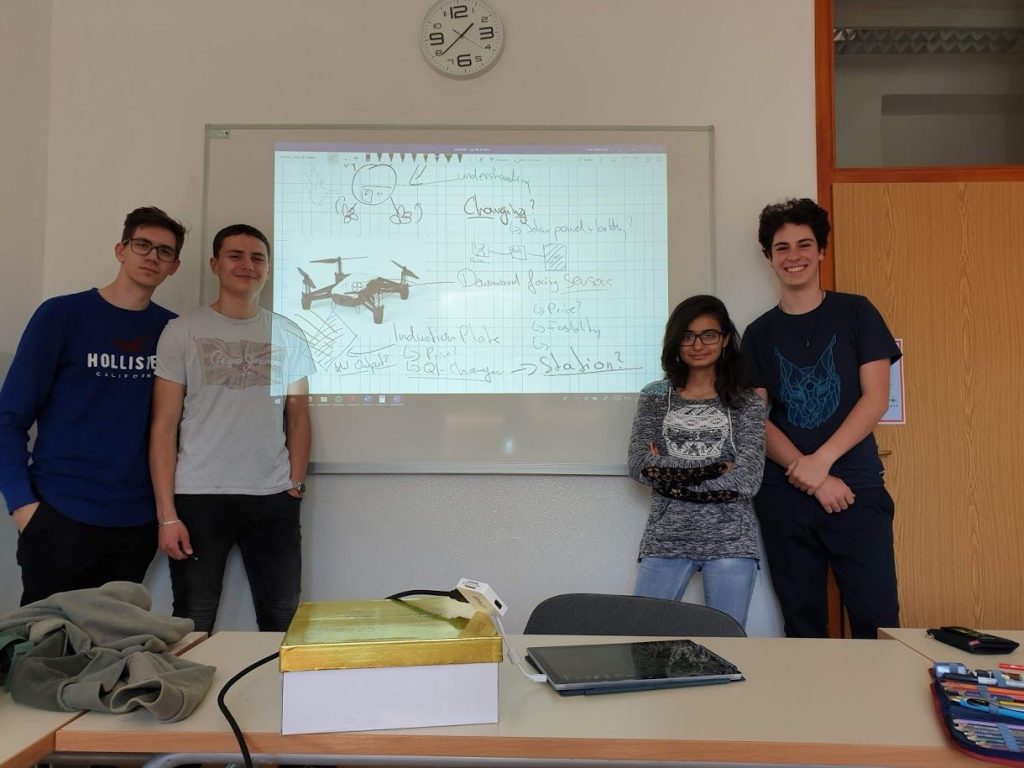
Despite their captivating performance in the preliminary round, their hardest challenge was yet to come. Because the school had limited funds, it was next to impossible to provide financial help to the UWCIM team in order to participate in the London finals. The cost of the trip to London soon became their biggest problem. The team began writing letters to the school outlining their hard work through reports and videos. Eventually they contacted the sponsors of the school and finally the problem of boarding and lodging in the UK was solved and the school decided to provide transportation subsidy to the team. Unfortunately, this wasn’t the team’s final hurdle. The visa application of the team member Israa Draz was rejected, and the visas of the other three members were delayed. Two weeks before departure, just when everyone thought they would miss the final, two members received their visa. The team was overjoyed and the two students carried the team’s enthusiasm to London.
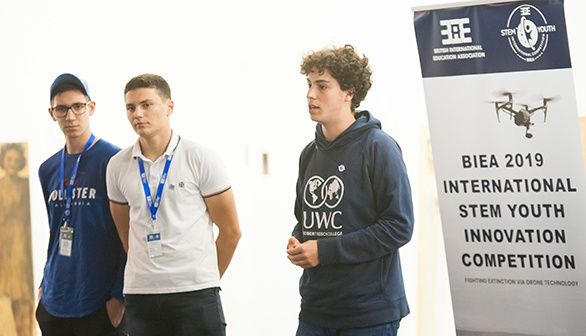
The UWCIM team was just one of the 28 finalists at the Royal Air Force Museum. The team responded well in all aspects of the competition. Under the precise command of pilot Aris Karamustafic, alongside two members of David Christian Busley, David successfully captured 11 valuable animal photos using superb flying skills, achieving zero collision, zero runaway and not to mention a safe landing. In the end, the UWCIM won the championship of the 15-17 age group and won the crown of the highest award in the competition, thus winning the overall prize of 5,000 pounds in one fell swoop!
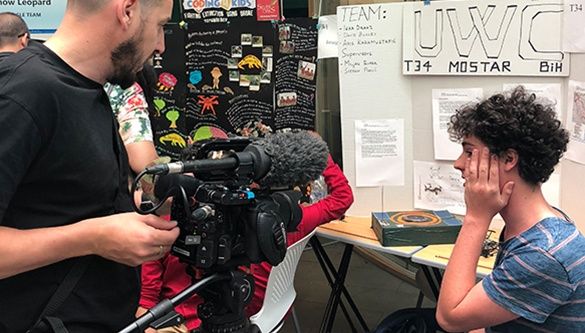
Team member Aris Karamustafic had a brief conversation with BIEA STEM Chairman David Hanson after the awards ceremony. He excitedly said to David: “I am from a small country, you may not be able to imagine, before coming to London, I have never been to the plane, have not been to a cruise ship, or even seen the subway. I have never expected to win the game with my teammates, because it is not easy for us to compete with other teams. The fact is that we won the championship. This feeling is really amazing and wonderful! Thank you very much for the BIEA STEM Competition. Thank you for giving us such great encouragement and courage. It is BIEA that makes us believe that science and education have no national boundaries. Today is definitely the best day of my life!”
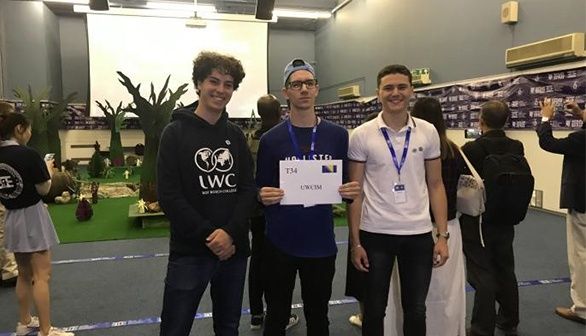
David also told the media after the competition that this year’s BIEA International STEM Youth Innovation Competition was not only a creative transformation competition for drones to save endangered animals, but also a brilliant showcase of the students’ performance in the field of science and technology. BIEA appreciates the sheer enthusiasm of the students in these projects, and is eager to push the competition to an even further international level. BIEA not only promotes the exchange of international science and education, but also provides students with a chance to realise their dreams!
Let us cheer for this champion team, and for this unique international youth science and technology event, and look forward to next year’s competition!
- Published in News
International Schools Scoop Top Prizes at BIEA International STEM Competition in London
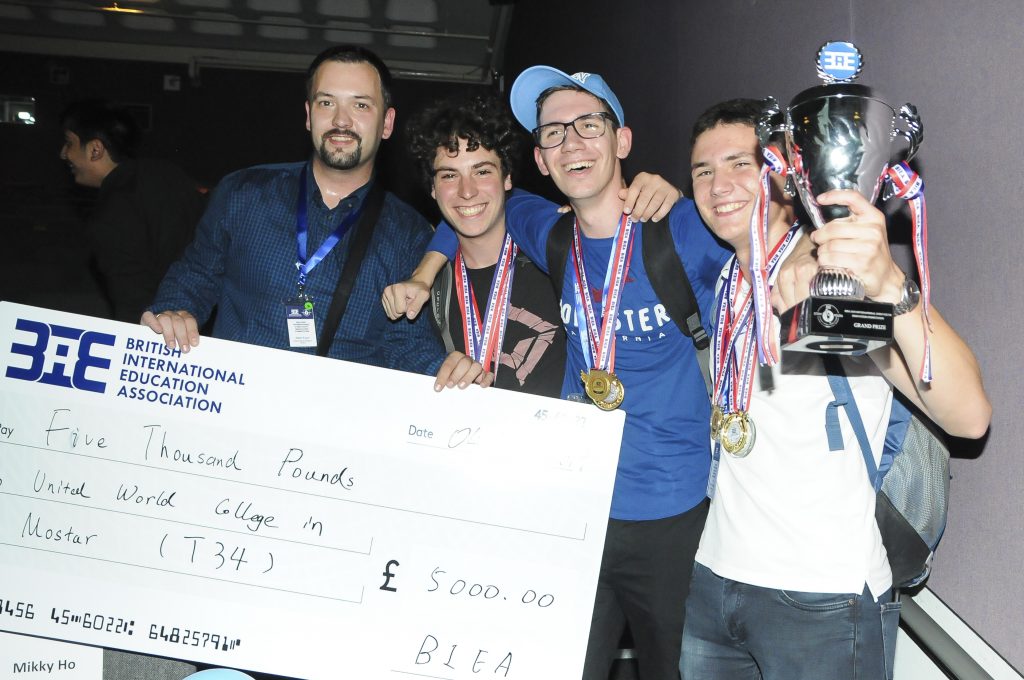
School children from around the world scooped some of the top awards at the finals of a major international STEM competition in London on 4th July where they showcased their ideas on how they would use drones to conserve endangered species.
Teams from the Silver Oaks International School (age 9-11 category) and Visakha Valley School (age 15-17 category) came won awards for Champions and Second Runner Up respectively. These teams spent the day speaking to judges presenting their ideas for animal conservation.
Coming from across the world, multiple teams from China joined the BIEA in London, taking two spots in the top awards of the day. They worked hard displaying their presentations, flying and evaluating their solutions to animal conservation via drones. Two teams from Hangzhou Shanghai World Foreign Language Primary School spent the day with the BIEA at the Royal Air Force Museum. The BIEA was happy to have multiple teams from the No. 2 High School of East China Normal University in London to represent their projects.
Taking an Outstanding Achievement Award in the 15-17 age category was the Macau Pooito Middle School team.
Team Delta Project from 1LO im. Stanislawa Dubois w Koszalinie in Poland snagged an Outstanding Achievement Award for their project that showed ways to help conservation efforts for the Grevy’s Zebras.
From Southern California, USA, two teams from the Topkids Center came to London to showcase their projects. In the 15-17 age group, Team Zuberi was awarded the Best Creativity and Best Display as voted by their peers. Team Paracop in age group 9-11 had their hard work paid off as they were awarded Champion for their age group.
The overall grand prize of £5,000 was won by the United World College in Mostar, Bosnia, for their impressive strategy to protect the endangered vultures of Bosnia and Herzegovina, a task made even harder by the estimated 80,000 landmines in 8,500 locations around Bosnia and Herzegovina left over from the Balkan Wars.
David Busley, 17, from the Bosnian team said:
“Vultures may have an image problem, but they are crucial to our country’s ecosystem. They are endangered, yet their plight often barely registers with many Bosnians as they are out of sight and out of mind.”
“Drones offer the perfect way to reach them safely in their natural habitat, and our hope is that by monitoring and tracking their numbers properly, we can encourage the government to take action to help conserve these vital animals.”
They all won a trophy and medals for their school.
More than 25 teams from countries including China, the USA, India, Pakistan, Bosnia and Herzegovina, Poland and the UK converged on the Royal Air Force Museum to contest the International STEM Youth Innovation Competition.
The competition was organised by the British International Education Association (BIEA), which champions British education ideals around the world, and backed by the Born Free Foundation, the competition aims to fire the imagination – and test the creative and technical expertise – of young science students with the theme of “Fighting Extinction via Drone Technology”.
Finalists in the three age groups – 9-11, 12-14 and 15-17 – from 18 countries were shortlisted for the grand final. Each school was given a budget of just £100 to build a drone for their entry, ensuring a level playing field. They battled it out in a day of tough competition, during which saw them each fly their drone and explain how they would use the technology to tackle species extinction.
Judges headed by the Chief Scientist of the Born Free Foundation, Professor Claudio Sillero, Dr. Shaun Fitzgerald of The Royal Institution and STEM Chairman of the BIEA David Hanson, also included drone expert Stephen Prior from Southampton University, Education Innovations Manager for the British Science Association Jane Dowden and Competition Manager Amelia Perry from Engineering UK.
The STEM competition runs each year with a different theme. In 2018, schools were challenged to create a drone for a rescue situation. Registrations are already open for the 2020 competition at http://bit.ly/2VqzoJH.
For your information
Drones that were used for the final round of the competition, it was the Tello / Tello EDU drone from DJI. Tello EDU is the educational version for individual or classroom usage to learn programming and DJI provides the best and safest solution globally as it always does in its Ariel products. We would also like to thank DJI for assisting us with the drones. More information can be found at their website: https://www.dji.com/uk/products/steam
- Published in News
BIEA 2019 International STEM Youth Innovation Competition Technological Achievement Showcase
The BIEA 2019 International STEM Youth Innovation Competition finalists showed their works at The Big Bang London Science and Innovation Exhibition held in Kingsway College in Westminster, UK on 3rd July 2019. Being a part of this year’s science and technology innovation exhibition and a part of the final of the competition, these finalists have attracted many international science and technology innovation experts and scholars, as well as well-known science and technology enterprises and institutions.
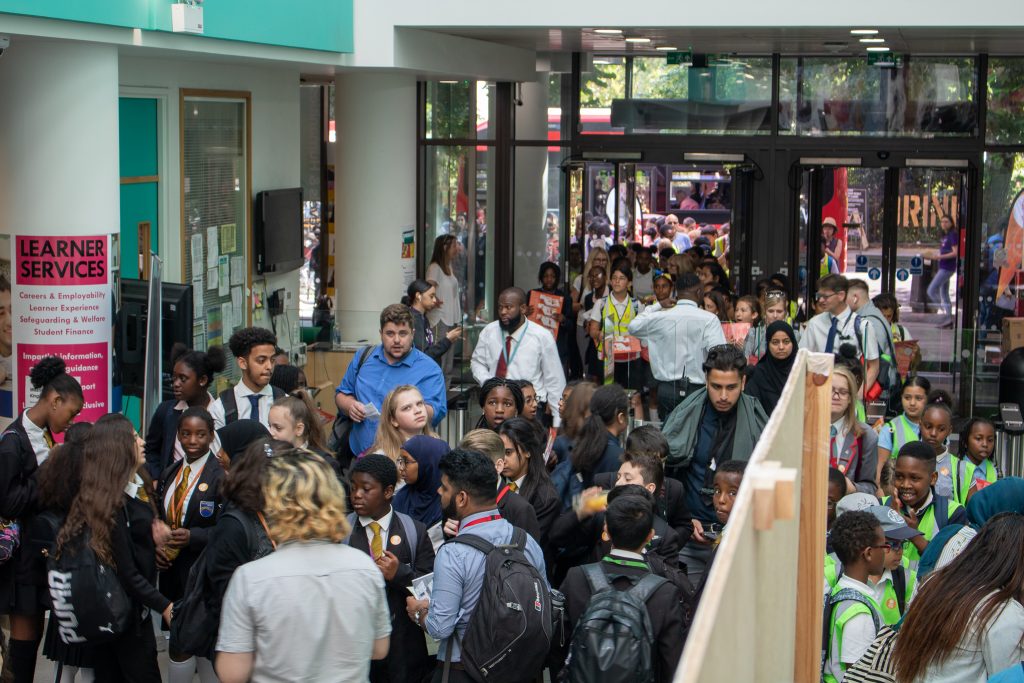
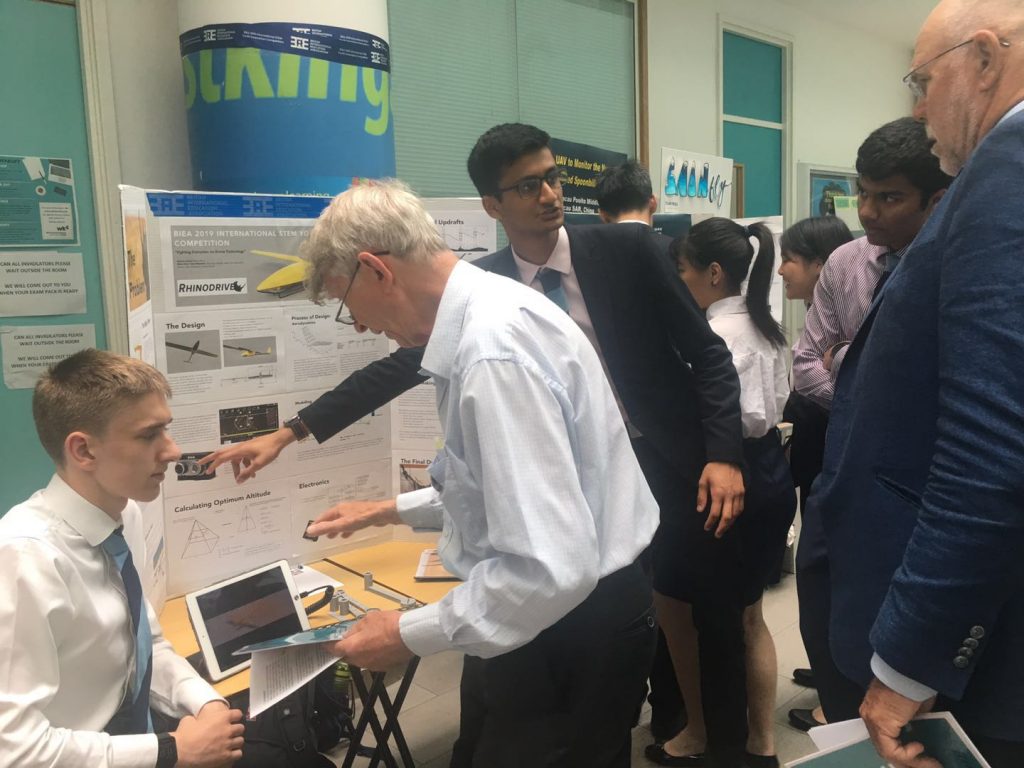
Students from the UK, USA, Poland, India, Bosnia and Herzegovina and other countries attracted the attention of science and innovation enthusiasts, experts and scholars. Local school teams were flocking onlookers to their booths. The Queen Elizabeth school team has been busy talking to science and innovation experts who have come to see their work. The team from Coleraine Grammar School in Northern Ireland studied the connection between the camera, the winch of the drone body and waterproofing measures in their preliminary report. The original rescue idea of Bactrian camels and African penguins by the team from the Topkids Center of the United States was eventually transformed into a surprising UAV transformation work, which received comments and discussions from young peers and experts of science and technology innovation from all over the world at the science and technology innovation exhibition.

Nikki Collins, CEO of BIEA, believes that the high standard of the final work not only reflects the high quality of the BIEA International STEM Youth Innovation Competition, but also represents the knowledge seeking and exploration of science, technology and innovation by the world’s youth. The theme of “Fighting extinction via drone technology” not only focuses students on science and innovation, but also leads them to think about what scientific and technological innovation can be used for, which is the focus of training future international talents.

- Published in News
BIEA 2019 International STEM Youth Innovation Competition Final judges – Have a glimpse of them!
The final of the BIEA 2019 International STEM Youth Innovation Competition will be held in London, UK on 4th July. On the eve of the final, the super-strong judging panel composed of many famous experts and scholars in the field of science and innovation in the UK will gather together at the Royal Air Force Museum. At that time, each of them will use their STEM or animal conservation expertise to provide authoritative and fair reviews of the event for both the final teams and the audience following the event.
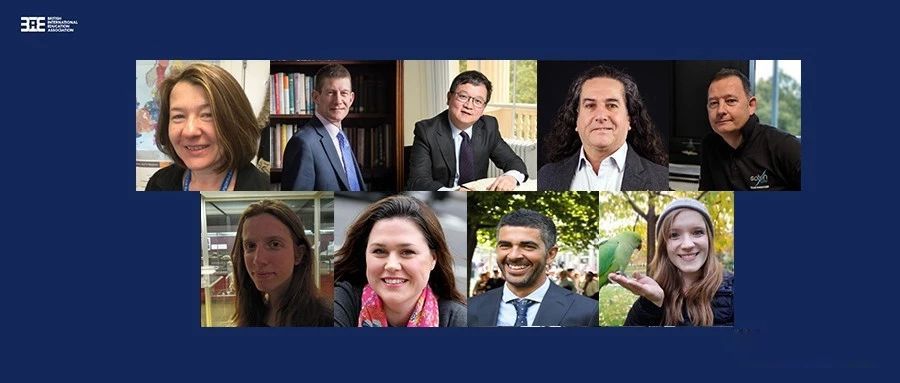
Dr. Alex Holmes, designer of the BIEA STEM Competition, is one of the judges. As the winner of the UK’s 2015 National Science Teaching Award, Dr. Alex has made outstanding contributions to UK STEM education. During her more than 20 years in STEM education, she has not only delivered speeches on promoting STEM education around the world at many international conferences, but also wrote STEM curriculum books for relevant international schools.
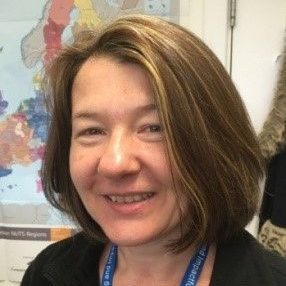
In addition to the well-known Dr. Alex, Dr. Shaun Fitzgerald, President of the Royal Institution, is a key judge for the final. Under the leadership of Dr. Shaun, the Royal Institution continues to create opportunities for people to understand the importance and stimulate public discussion of science. In addition, Dr. Shaun is a visiting professor at the Royal Academy of Engineering at the Cambridge University’s Department of Engineering, and is a Teaching Fellow in Engineering at Girton College.

Claudio Sillero, chief scientist at the Born Free Foundation, is also on the judges’ list. Professor Claudio is currently based at Oxford University’s Wildlife Conservation Research Unit (WildCRU), Chair of the IUCN Species Survival Commission Canid Specialist Group and founder of the Ethiopian Wolf Conservation Programme. Professor Claudio has rich practical experience in wildlife conservation and can provide professional wildlife conservation opinions for the work of the finalists.

The BIEA 2019 International STEM Youth Innovation Competition features experts from STEM and animal conservation communities, as well as managers from world-renowned technology companies and educational institutions. Professor Yike Guo, a global pioneer of data-driven science and technology, is one of them. The innovative cloud-based informatics platform developed by Yike is an important engineering achievement of the electronic science project in the UK. In addition, the other judges are experts in the field of Unmanned Air Vehicles – Stephen Prior, the Schools Programme Manager at the Digital Impact and Sustainability team – Louise Medland, the Big Bang Competition Manager Amelia Perry, and from Materials Chemistry Centre and a Senior Research Associate at the University College London, Raul Quesada.
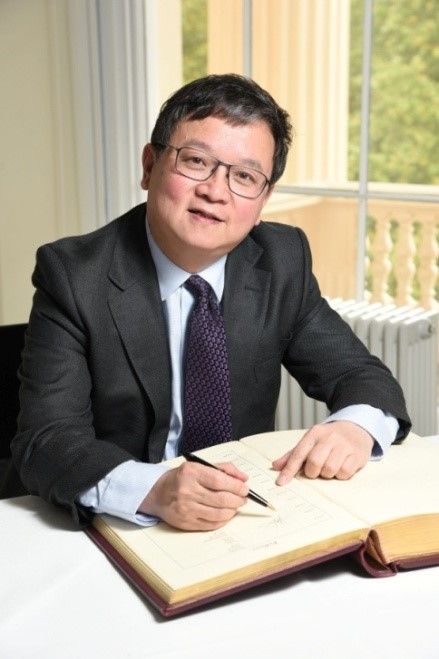
I believe that with the enthusiastic support of these judges with a strong STEM and animal conservation background, the final of this international STEM competition will be more exciting and interesting. And STEM teenagers from all over the world will benefit from the judges’ wonderful comments and continue to innovate for the future we hope to see!
- Published in News
Royal Air Force Museum hosts the final round of the BIEA International Youth Science and Innovation Competition
The 2019 International STEM Competition, organised by the British International Education Association (BIEA), will be held on July 4. For this annual competition of science and innovation, all the staff and expert consultants of BIEA are making every effort to bring the best competition experience to the science and innovation talents that are coming from all over the world. Speaking of which, we have to mention the Royal Air Force Museum, which is the venue of the final round of competition.
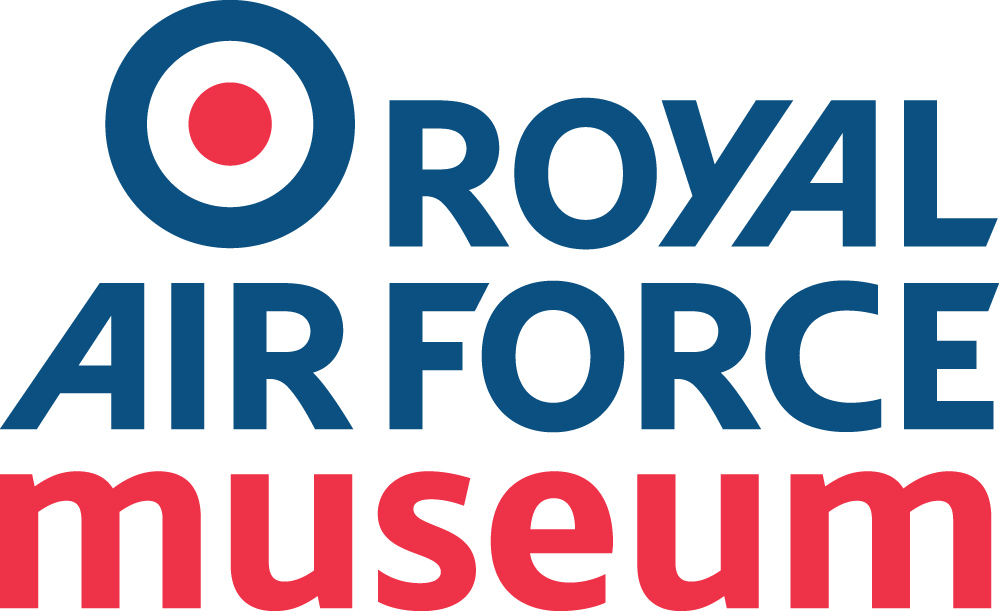
The Royal Air Force Museum, as a non-government, public institution, is the only national museum dedicated to the aviation industry in the UK. The museum is made up of six hangers used to display a variety of military aircraft, with over 130 real aircraft distributed throughout the museum, as well as numerous aircraft models, and air force uniforms and souvenirs. The museum designers have cleverly combined the exhibition space with interactive elements to create a unique display space in the exhibition hall. The final of the 2019 BIEA International Youth Science and Innovation Competition will be held in the activity halls located in Hangar Three.
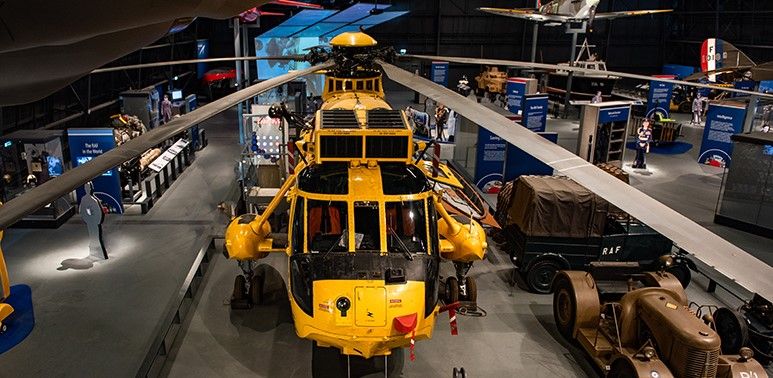
According to the organising committee of the competition, all finalists will compete in groups and draw lots to determine the order of competition. The final competition will be held in three different spaces at the same time: Display space — used to allow each team to display their design ideas and results; Evaluation space — the judges will ask questions according to the thesis and video submitted by each team, and all contestants will have an opportunity to reply. Flying space – teams must complete the flight tasks required by the competition in a limited time, this is the ultimate test of the players’ flying skills! Judges will be assigned to different spaces, according to their areas of expertise, to mark the competition.
“The final process design not only fully demonstrates the fairness of the competition, but also maximizes the enthusiasm of the participating teams”, said Alex Holmes, designer of the Science and Innovation Competition.
On the day of the final round, teams from all over the world will enjoy a special BIEA award ceremony and a traditional British celebration dinner party after the fierce final competition.
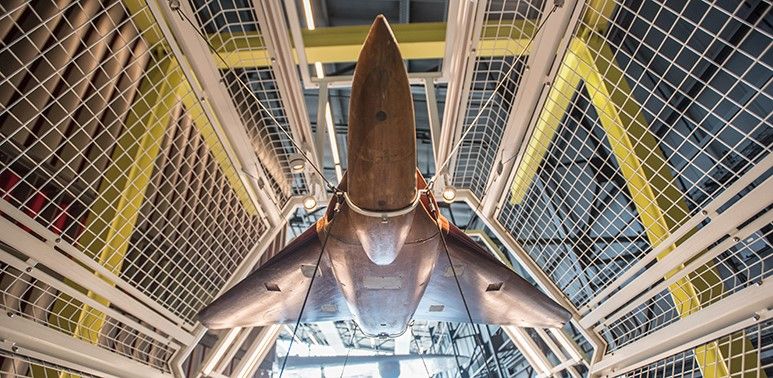
Vicki, director of external co-operation at the RAF Museum, said, “the RAF Museum has been promoting aviation since it was established in 1972. We not only hope to attract people to come to the Museum who know about airplanes and aviation history, but also hope to create an experience space for teenagers to fully learn about aviation knowledge. This happens to coincide with the theme of 2019 BIEA International Youth Science and Innovation Competition, drone war against species extinction. We are delighted to work with BIEA to bring scientific and creative talent from around the world to the Royal Air Force Museum.”
- Published in News
Observe the World Through Science and Innovation
On June the 4th the teams competing in the BIEA International STEM Youth Innovation Competition submitted their video presentations.
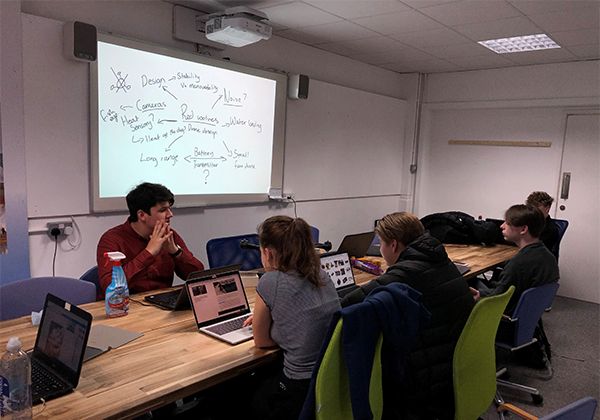
Among the many teams submitting very imaginative projects is Chester International School from the UK. Chester International operates a paperless educational approach. All teaching activities are carried out on the student’s laptops and they are equipped with 3-D printers. This encourages enquiry and innovation in STEM disciplines and the BIEA competition is very much something Chester would compete in. The whole team was involved in the project from the beginning and the young woman member concentrated on referencing information regarding the Red Wolf whilst the young men concentrated on the design and construction of the UAV, both cross referencing and liaising where necessary. The team also referenced experts on 3-D technology and design before submitting their project. The BIEA competition was also designed to encourage team ethos and cooperative endeavour which, according to Montana Hull Chester’s teacher and leader has been achieved throughout. Ms Hull said that the spirit of teamwork and cooperation has been evident in Chester’s team since the beginning and especially when considering that they had not done any UAV work previously.
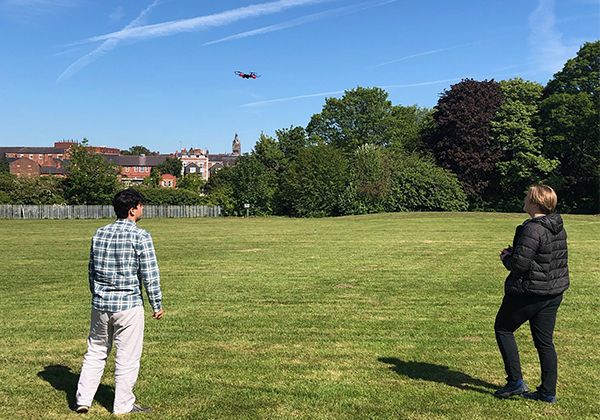
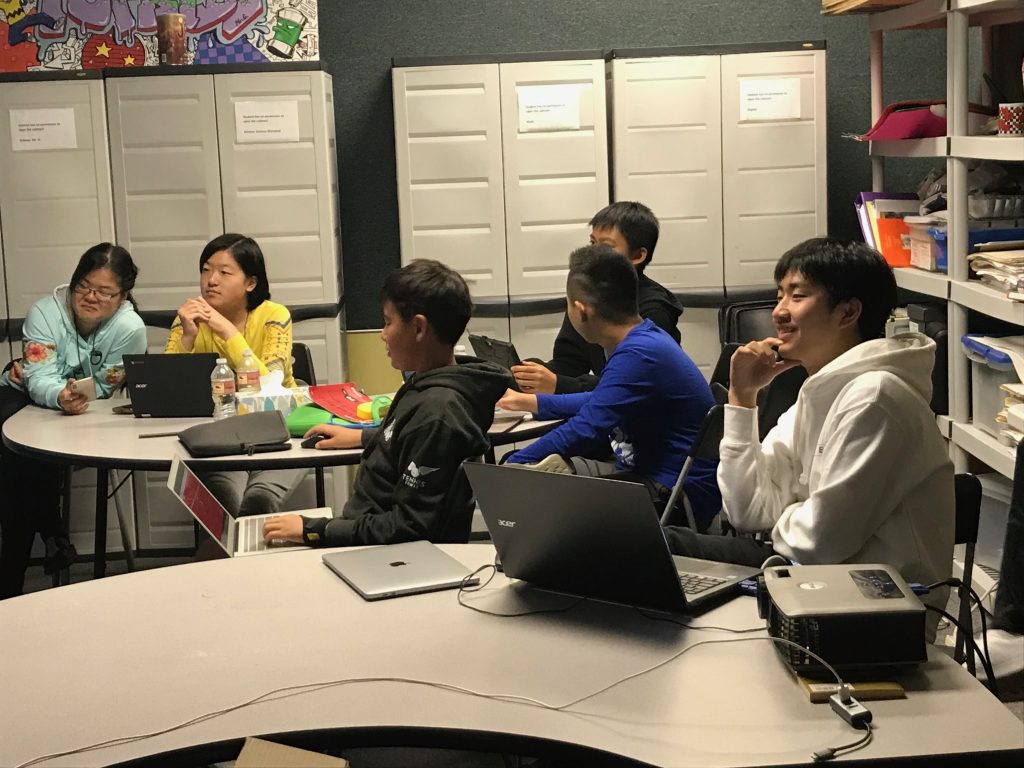
Another school that puts teamwork paramount is Topkids Center in Los Angeles. The USA school has two teams in the finals, one in the 12-14 age group named ‘Paracop’, and the other in the 15-17 group named ‘Zuberi’ Instructor and leader Chris Chai said that when they had first heard of the BIEA STEM Competition and had watched the video of last years competition they had become excited and wanted to enter. He said that it was a great opportunity to apply science and innovative thinking into protection in the real world and that having young students competing with their ideas and technologies from all over the world can only be beneficial to international cooperation and understanding. In selecting which animal to help the teams considered a number of endangered species which included Indiana Bats, iguanas, penguins, Blue-footed Boobies and camels. Eventually the Paracop team chose the Bactrian camel and the Zuberi team went for the African penguin. In preparation for the competition the two teams were encouraged to meet and discuss their respective projects and in this way the elder group gave much help to the younger in terms of technical expertise and flight operation and the younger came up with lots of innovative and interesting suggestions. Teacher Chris Chai offers some advice on how parents can better support their children’s interest in science and innovation, “almost everything around us is tied to science, technology, engineering and math (STEM). Develop your child’s STEM interests by first understanding what areas your child is truly interested in and then taking every opportunity to introduce STEM learning in that area.”
In the process of preparing for the competition, in order to encourage the children to inspire and communicate with each other, the teachers specially let the students of two age groups discuss together. In this way, the higher age group can give a lot of help to the lower age group in terms of technical expertise and flight operation, and the lower age group can come up with a lot of innovative and interesting suggestions.
Teacher Chris Chai also offers some advice on how parents can better support their children’s interest in science and innovation: “almost everything around us is tied to science, that area.”
- Published in News
Many schools from around the world show exceptional talent and ideas in the BIEA international competition
With the rapid development of science and technology and the pace of globalisation, the requirements for talent in the future world are being constantly refreshed. The concept of STEM education has been around for a substantial time but it has never received the global attention as it does today. With the announcement of the final teams list of the BIEA 2019 International STEM Youth Innovation Competition the international interest in using drone and other modern technology to help preserve endangered species is obvious.
A team from the United World College in Mostar (UWCiM), Bosnia and Herzegovina qualified for the finals in the 15-17 age group. As one of the world’s leading IB schools, (offering International Baccalaureate courses), the school entered a team to help protect vultures by using drones to track, observe and understand their life paths and to help solve the problem of vultures that feed on animal carcasses spreading disease and becoming a threat to the ecosystem.

The Mostar team transformed the colour of their UAV design and chose to navigate in specific areas only after careful study of the vulture and its habits and referencing expert opinion. Their biggest problem was keeping within budget to realise their ambitions. With help from the BIEA science and technology committee and careful thought into the design of the UAV and the aims of the team a project was submitted that successfully achieved the desired aims of the team.

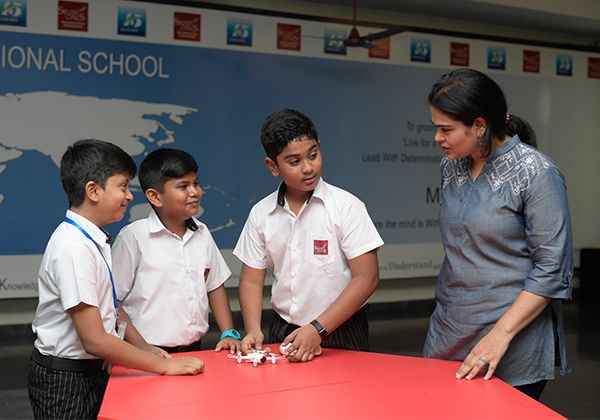
India has always been a country that invests heavily in technological development and innovation to encourage economic growth and this is reflected in their educational system. Sunitha Yernagula, Principal of Silver Oaks International School from Visakhapatnam in East India, spoke of the great excitement when the school knew that their team in the 9-11 age group had reached the BIEA competition finals. The team had decided to help Pangolins, which have been hunted for their skins to the point of extinction. The team’s proposed drone design will use programmes developed for python recognition to identify Pangolins in areas inaccessible to humans. The team leader Nagashilpa said that it would be an unforgettable experience for the team to attend the finals in London. She said that the competition provides a platform for students not only to learn technological skills but also to cultivate the idea of using that technology to facilitate animal and environmental protection.
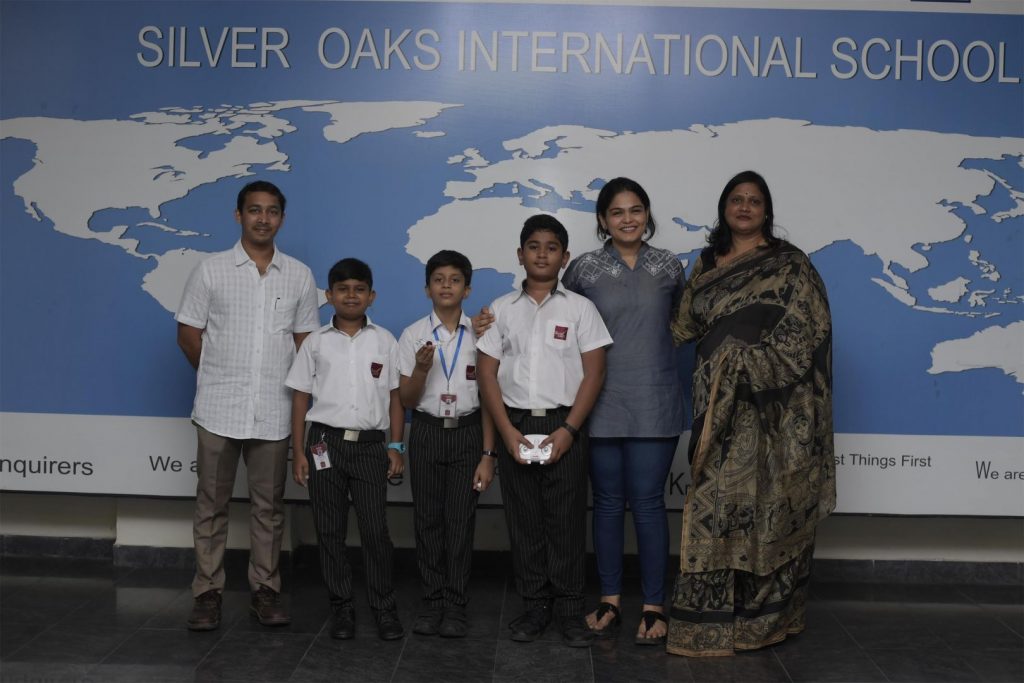
As well as India and Bosnia and Herzegovina, Sri Lanka has a commitment to science and technology education in its educational system. Gateway College in the capital Colombia has a team that has qualified in the 12-14 age group. Gateway College has a large investment in STEM education and has a specific area dedicated to technological innovation set aside at the centre of the school for that specific purpose. The team decided to help to understand Asian Elephants and developed a drone technology to help count and video their habits. A sophisticated sensor was used in their drone design.
Science and technology education is becoming increasingly important internationally and the more cross national cooperation in this field is encouraged the more it can benefit not only the environment but also the species therein including mankind.
Laura Gosset of The Born Free Foundation and partner in the BIEA International STEM Youth Innovation Competition in 2019 said that it is important for The Born Free Foundation to participate in the event to encourage wildlife conservation. Laura also said that it is a great opportunity to improve children’s science and innovative skills and raise in them an awareness of ecological protection. She also said that any event that publicises the protection of endangered animals at an international level can only be hugely helpful.
- Published in News
Centuries old Grammar School reaches the STEM final. Queen Elizabeth’s School enthusiasm for modern technology
As a country with a long tradition of innovation in science and technical instruction with a long history of STEM education and as the host of BIEA 2019 International STEM Youth Innovation Competition, Britain not only leads the number of participating teams in this competition but also has had a remarkable success in the preliminary rounds of the competition. One of the teams entering the final is Queen Elizabeth’s School in Barnet. The boy’s school was founded in 1573 under a charter granted by Queen Elizabeth the first and today, besides providing the traditional comprehensive education expected of a traditional grammar school, encourages inquiry into unmanned vehicle technology, VEX robotics and other cutting-edge technologies and has won many awards and international competition.

Regarding their interest in the competition the school science and technology department director, Michael Noonan, said that earlier this year one of his students, Aryan Jain, saw the notification of the BIEA international STEM competition whilst browsing the web and very quickly others became interested and a school team was formed to compete.
The teachers were very supportive of the student decision to enter the competition and encouraged them to explore their ideas independently. Michael Noonan said, “From the initial selection of animal species to the creation of the report and to the development of the UAV according to their designs, it was all the result of the team’s own little by little exploration and progression.”
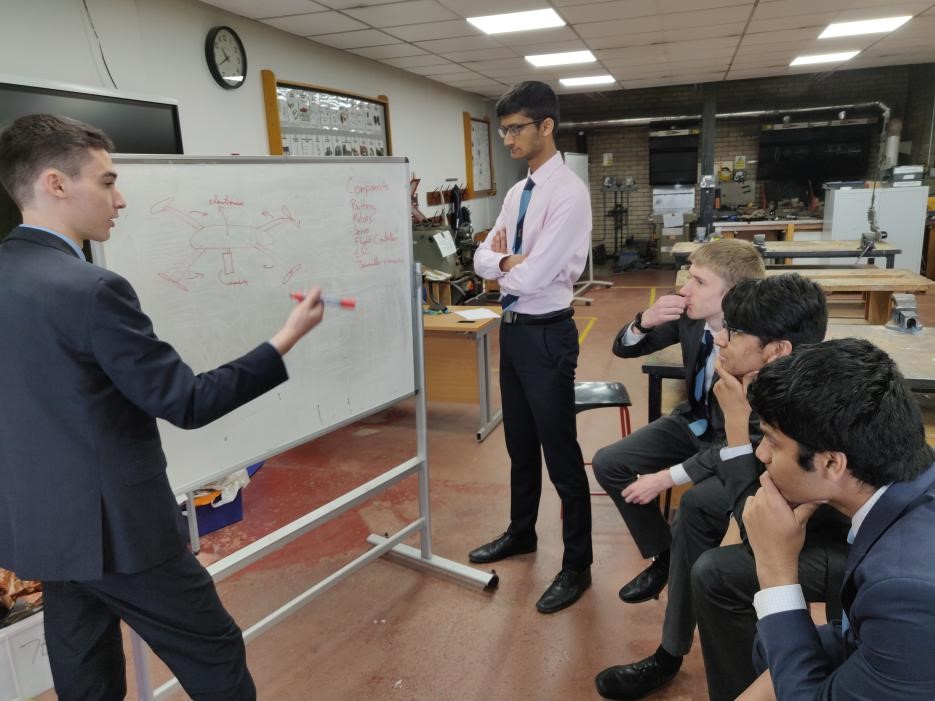
The team members are discussing which animal to choose to help protect. The team drew up a long list of endangered animals and explored the role drones could play in protecting them. As a result of the discussions the team members were enthusiastic to develop glider drones and choose an animal with a large distribution area hence the choice of the Black Rhino.
After referencing the relevant publications the team decided to use military surveillance techniques to aid in the protection of Black Rhinos. A complex equation derivation was successfully used to calculate the pixel resolution in the final design.

The team is working together to remodel drone parts
The final report and submission for the competition final deadline coincided with school examinations. How not to interfere with study for the all-important examinations? The boys were very enthusiastic to enter their drone design in the competition but were as equally concerned to complete their studies for the examinations. To this end a detailed division of work to be done was scheduled to be carried out outside of study time. Two days before the report had to be submitted the team had to work more than 14 hours a day to complete it. The hard work paid off and the report was submitted on time.
Having reached the finals the team was so enthused that they decided to build their drone themselves in order to present their design to the fullest. This has increased the difficulty but is definitely well worth the extra effort.

The team were divided into three sections, a group responsible for electronics, another responsible for the video and another responsible for the fuselage. The electronics group focused on providing the power and the control system and system compatibility. The video group made the video submission, wrote scripts, arranged 3D printing and coordinated the budget etc. The fuselage group designed the chassis and structure of the drone – all are coming together to provide the finished entry.
Despite the small number of team members the preparations for the final are proceeding in an orderly manner under the divided group responsibility and with close cooperation. Everyone in the team is looking forward to the science and technology innovation competition finals on July the 4th.
Michael Noonan is extremely proud of his students and the effort that they are putting into the project. When the team found out that they had been selected for the finals the rest of the school was enthused with interest in the BIEA STEM Competition and he believes that more students will show interest and compete in any future competitions.
- Published in News
Scientific innovation inspires youngsters in STEM
With the finalist list announced the BIEA (2019) international youth science and innovation competition the atmosphere continues to intensify with the teams entering the final preparatory stage. The reports submitted in the preliminary contest not only reflect the understanding and cognition of each team of aspects of scientific innovation, but also represents the level that teenagers in different countries and regions have achieved. Being a leader in China’s economic development Shanghai has always attached great importance to science and innovation in education. The four teams sent by the second affiliated middle school of east China University in Shanghai are honoured to have reach the final to be held in London.
Students wholeheartedly embraced the project
The theme of BIEA (2019) international youth science and technology innovation competition is “drone wars and species extinction”. The combination of the popular UAV technology with humane animal protection projects has attracted active participation from schools from around the world. This includes the second affiliated middle school of East China in Shanghai. Due to the large number of students that have enrolled for the project the school selected two teams in the 12-14 age group from the Junior Middle School and one team in that age group and another aged 15-17 from the International Department to participate in the competition.

Although they love science and innovation, how to combine drones with animal protection was still a great challenge for the children. Teachers Yang Bing and Chen Giong asked experts from Shanghai Jiao Tong school of aeronautics and astronautics to give advice and help. The International Department and the Agricultural School in the University arranged for the children to visit the drone base of the university to experience examples of the uses of drone technology. This increased the enthusiasm and excitement amongst the children for the competition.

Brainpower and hardwork. UAV design fun
After discussion with teachers and comprehensive research children quickly chose the animals to be protected by their teams and modified the UAV designs according to the environment and habits of the animals selected.
The Typhoon group of students in the Junior Middle School chose the Chinese flying squirrel with multiple teeth as the animal to protect. Because of the nocturnal habits of the flying squirrels the students decided to use a wide-angle camera to observe and locate the caves they inhabit during the day and then use the night vision camera to observe and count the population at night. The advantages and disadvantages of all kinds of equipment were assessed and used to help them complete their objectives.

The UAV Cavalries team, another team from the middle of the primary school, selected the Asian elephant to help protect. They had to consider such things as counting the population, the encroachment of poachers and the availability of water. All of this was considered and researched in creating their project.
The junior high school and senior school teams of the International Department chose snow leopards and Chinese alligators as their animals to help protect. Each carried out comprehensive research on their respective animals and used their spare time to investigate design and construction characteristics of drone technology. The whole experience was very enjoyable.
The challenge was met and all four teams are finalists
The UAV design and modification process greatly facilitated the children’s creative thinking as well as their ability to research projects and develop the attendant skills. One of the many things that the students from the International Department’s 15-17 age group team discovered during their research on the Chinese alligator was that it’s skin colour was so close to that of the rocks on which it basked that it was difficult to see and that it was poikilothermic (cold blooded) and could not be tracked by an infrared camera.
To overcome this problem the team researched the habits of the alligators and discovered that they liked to float on the water and that their eyes glowed red when illuminated at night. This enabled the team to devise a method for counting the alligators with their drone.

During one of the flights to test the design of the drone near a school pond the sound startled a water bird catching fish and it’s wings knocked the drone. Fortunately, all was not lost and the children guided the drone to a save landing in a large stone in the middle of the pond. Yan Li, a science teacher and innovation instructor at the school was full of praise for the way the children handled the crisis.

The science and technology innovation competition is a perfect opportunity to exercise children’s science and technological innovation ideas and practical ability. The competition also allows the children to express their very human instincts in their desire to protect wild animals whilst displaying their innovative and technological skills to others from around the world and experts in STEM education. This can only bode well for the future.
When we found out that our team had been shortlisted for the finals and that we were going to London to participate we all cheered. We are full of pride and are honoured in the mission to compete with other school teams from around the world. I hope that the preparations for the finals that we are making at present will result in a most enjoyable time for all concerned and that Shanghai will prove a worthy competitor in the competition.
- Published in News
Impressive works by students in 2019 BIEA STEM Competition
One of the results of organising this competition, amongst others, is the quality of illustration and drawing exhibited by the school teams across the age groups.
The drawings of the distribution of snow leopards and maps of China submitted by the Hangzhou World Foreign Language school in the 9-11 age group are charming (above). What is equally stunning is the wonderful illustration of a tiger painted drone with a tiger faced centre submitted by Ravenswood School For Girls in the same age group. Their power point report is also very well done.
The photo and reasoning of the drone design submitted by the No. 2 High School of East China Normal University are equally clear in the 15-17 age group.
Many of the drone designs in the older groups are fascinating and ingenious. One submission that stands out technically is from the Koszaline secondary school 1 LO 1m for the preservation of Gray’s Zebra. Their innovative design and technical reasoning is amazing.

The imaginative use of material in construction of the designs was surprising. No 2 School Shanghai’s reasoning for and explanation of using graphene in their drone is very interesting. Queen Elizabeth’s School Barnet’s reasoning for using a fixed wing design is equally impressive in their desire to help the Black Rhino. The clear reasoning and explanation of the design of India’s Visakha Valley School’s drone design including a clever use of Raspberry Pi in the desire to track the Red Panda in it’s environment is fascinating.
Hisar School from Istanbul intriguingly propose to use of mycelium as a material in the construction of their drone designed to assist Mountain Gorillas and Pangolins.

Other finalists have chosen to help complex toothed flying squirrels, basking sharks, tasmanian devils and other endangered animals with their projects and the finals in July look to be a very exciting and rewarding occasion.
- Published in News











